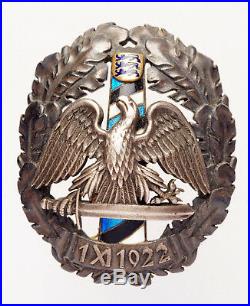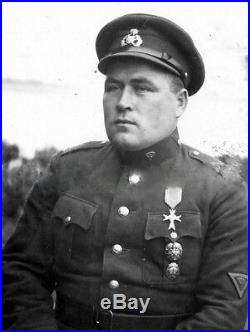
RARE Estonia Border Guard Badge Silver and Enamels Original






Badge, in Silver and Enamels. The badge was established in 1932 and was used until the. By the Soviet Union in 1940. Full size badge made by. Silver, gold, hot enamels, 43 x 35 mm. The painter Günther Reindorff designed the Border Guard badge for the tenth anniversary of the Border Guard of Estonia in 1932. The basis of the badge is an oak wreath. Inside the wreath is an eagle holding a sword in its paws. The eagle protects the borderline, which has a national coat of arms. All this symbolizes the self-proclivity and courage of the border guards in protecting the state borders of the Republic of Estonia. On the lower edge of the ridge there is the date of the establishment of the border guard – November 1, 1922. The figure of the Nordic eagle, known from the national epic, symbolizes alertness, courage and combat readiness. “The Border Eagle Badge” expresses the vigilance and determination of border guards and symbolizes virility and cohesion. The Border Guard badges were manufactured by the Roman Tavast workshop in Tallinn. Only a Badge is for sale. Other photos are for information only. The Estonian Border Guard (Estonian: Eesti Piirivalve) was the national security agency responsible for the border security of Estonia. It was subordinate to the Ministry of the Interior. The Border Guard also assisted with Search and Rescue missions. In 2010, the organization was superseded by the Police and Border Guard Board. History from independence(1918) to WW II. On November 14, 1918, admiral Johan Pitka organized a meeting to discuss the guarding of borders of the freshly established Republic of Estonia. On November 18, 1918, the Border Guard government (Estonian: Piirivalvevalitsus) was established, with captain Leopold Tõnson leading it. Until 1 January 1919, the agency was subordinate to the Estonian Defence League Council of Elders (Estonian: Kaitseliidu Vanematekogu), but was then subordinated to the Ministry of Finance. Since 1 February 1919 until the end of the Estonian War of Independence the borders were guarded by the military. Since 15 February 1919 until May 1921 the crossing of borders was checked by the Republic’s Border Control Government (Estonian: Vabariigi Piirikontrolli Valitsus). On 30 May 1922, the border guard agency was subordinated to the Ministry of the Interior. Following the recommendation of Minister of the Interior, Kaarel Eenpalu, the Border Guard Government (Estonian: Piirivalve Valitsus) (not to be confused with the previous Border Guard government) was established on 20 September 1922. Lieutenant colonel Ants Kurvits was appointed to lead the organization on 1 November 1922, which is also considered the official formation date of the Estonian Border Guard. Lieutenant colonel Arved Engmaa became his deputy. On 1 December 1922, the Estonian government approved the structure of the agency, consisting of: a headquarters, departments, districts, and cordons. The headquarters started work in January 1923, at the White hall of the Toompea Castle. Positions were manned with reserve officers from the military and conscripts serving under a one year contract. By May 20, 1923, all control over the border was transferred from the Defence Forces to the border guard. There were eight district stations: Tallinn, Läänemaa, Pärnu, Valga, Petseri, Tartu, Peipsi and Narva. On 1 December 1923, Valga station was joined with Petseri, and on 1 July, Tartu station was joined with Peipsi, and Pärnu was joined with Läänemaa into Lääne station. On 16 February 1923, a corporation for officers was established. On 16 June 1927, a similar corporation was established for the conscripts. Until the mid 30’s, the legal ground for the activities of the border guard was based on an old law, established under the Russian Empire. On 5 June 1936, a new Border Guard Act was entered into force. Despite legal agreements with the Soviet Union, a tragic incident occurred on 8 February 1938, when Soviet border guards entered Estonian territory and killed two Estonian border guards and one civilian. On the 10th anniversary of the Border Guard, the agency received its flag. In 1940, the agency was partially disbanded by the occupying Soviet Union forces. The eastern border structures were demolished. By then there were roughly 1100 border guards. Large number of Estonian Border Guard officers were repressed and sent to Gulags. From Estonian Border Guard home page. Independent statehood created a need to guard the borders of Estonia. On 14 November 1918 Admiral Johannes Pitka convened the very first meeting on guarding-the-border issues. On 18 November 1918 the Border Guard Administration became operational under Captain Leopold Tõnson. Until 1 January 1919 the Administration was subordinated to Defence League Board of Governors and later for a short time to the Ministry of Finance. Beginning from 1 February 1919 until the end of the War of Independence and also first post-war years military units guarded Estonian borders. From 15 February 1991 to May 1921 Border Control Administration of the Republic of Estonia was responsible for controlling border crossings. The then Minister of Internal Affairs, founder of Estonian border guard Karl Einbund (Eenpalu) underlined in his speech on the fifth anniversary of the Republic of Estonia that in peace-time the army learned but did not rule. We have to adhere to the old truth: the army cannot execute civil governance in the peace-time. If civil governance is assigned to a military organization, a permanent specially prepared unit has to be founded, subordinated to civil power. According to Karl Einbund, the latter is of special importance as by nature military maxims and guarantees are not for the peace-time. On 30 May 1922 the Riigikogu passed a law subordinating the border guard to the Ministry of Internal Affairs. The Border Guard Administration was founded on the proposal of Karl Einbund on 20 September 1922. A well-known military leader from the War of Independence Lieutenant Colonel Ants Kurvits was appointed the head of the border guard and he assumed office on 1 November 1922. This date is considered the birthday of Estonian border guard. Lieutenant Colonel Arved Engman, former commander of the 6th Infantry Regiment of Estonian Defence Forces, was appointed Assistant Head of Border Guard Administration in the capacity of deputy head. On 1 December the Government of the Republic of Estonia approved the structure of Estonian border guard: General Administration, i. Command Centre and sections, regions and sectors. The Command Centre founded in January 1923 started its work in the White Hall, Toompea Castle. Personnel comprised of officers taken from reserve to active service or transferred from military units as well as of extended servicemen serving with one-year contract in the border guard. By 20 May 1923 the entire border had been taken over from the Defence Forces. There were eight sections responsible for the border: Tallinn, Läänemaa, Pärnu, Valga, Petseri, Tartu, Peipsi and Narva sections. On 1 December 1923 Valga section was liquidated and joined to Petseri section. On 1 July Tartu section was merged with Peipsi section and Pärnu and Läänemaa sections into Lääne section. On 16 February 1923 Border Guard Officers Association and on 16 June 1927 Border Guard Extended Servicemens Association were founded in order to organize officers and extended servicemen. Until 5 June 1936 the operation and organisation of Estonian border guard was legally based on the czarist Border Guard Corps Act of 1910, several provisions of which were amended and replaced with the legislation of the Republic of Estonia. On 5 June 1936 the Border Guard Act, issued as Head of State Decree from 25 May 1936 entered into force. Estonian border guards guarded 1159 kilometres of border in the north and south, 276 kilometres of Estonian-USSR border in the east and 365 kilometres of Estonian-Latvian border in the south. The border guard worked hard to detect smuggling on the sea border and on the southern border. On 8 August 1927 the Republic of Estonia and the USSR signed an agreement on the regulation of border incidents, which entered into force on 20 January 1928. Despite the agreement a tragic incident took place on Lake Peipus, near the Estonian-USSR border on 8 February 1936: having crossed the Estonian border Soviet border guards killed the head of Ninasi sector sergeant major Artur Pungas, guard private first class Voldemar Kaio and non-border-guard driver Vassili Eva. The maintenance of the state border was extensive: renovation of boundary posts, repair of wire fences, cleaning of boundary ditches and strips, construction of patrol routes and observation towers. Accommodation was really poor in the early years of Estonian border guard. The border guards lived in earthen huts and farms. Orchards and ornamental shrubs were planted; lawns and nurseries were made at border guard sectors. Border guards were active in sports and social life. Swimming, shooting, light and heavy athletics as well as skiing were primary sports. Lieutenant Colonel August Engman, chairman of the Border Guard Officers Association was one of the founders of Estonian Shooting Union. Border guard Eduard Seren from Omedu border guard sector was a member of the Estonian small-rifle team at World Championship in Rome in 1935, establishing a world record. In 1934 1937 in competitions of Estonian shooting unions member associations and districts the border guard team won four times in succession a challenge cup given by the minister of war. The people of Estonia recognized the commitment of the border guard highly. On the tenth anniversary of the border guard Estonian County Governments Association presented the border guard with a nice flag: with a state emblem on one side and county emblems and border guard emblem a boundary post defended by an eagle with spread wings, holding a sward – on the other side. Prior to the annexation of Estonia by the Soviet Union the borders of Etonia were defended by Tallinn, Lääne, Petseri, Peipsi and Narva sections, 164 border guard sectors and 1100 border guards who knew that should borders disappear, the country will disappear, the state will disappear, the freedom of its people will disappear (Major Johan Paul, 1932). Soviet occupation in 1940 interrupted the operation of the independent Estonian border guard. Buildings on the eastern border were destroyed and border constructions were dismantled. The southern border with the Republic of Latvia, also occupied by Soviets, survived until German occupation in 1941. The structure and personnel on the Latvian border was maintained. In January eight officers led by Colonel Johan Paul worked in Border Guard Division in Peoples Commissariat of the Estonian SSR. The partial survival of the border guard in the first Soviet year allowed later merging of organized armed opposition with the resistance movement. A vast majority of Estonian border guard officers were repressed and most of them lost their lives in Gulag prisons. The first head of the Estonian border guard Ants Kurvits (VR1/2) who retired as Major General in late 1939 was murdered on unknown circumstances in Gulag. The item “RARE Estonia Border Guard Badge Silver and Enamels Original” is in sale since Wednesday, November 14, 2018. This item is in the category “Collectibles\Militaria\1919-38\Original Period Items”. The seller is “pelin60″ and is located in EU, Riga. This item can be shipped worldwide.
- Country/Region of Manufacture: Estonia
